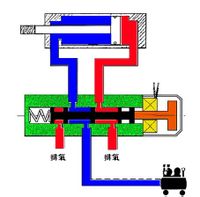How to match the cylinder and solenoid valve
Single-acting cylinder--3-way solenoid valve
Double-acting cylinder--4.5-way solenoid valve
Control various fluids-2.3-way solenoid valve
The switching actions of the double-acting cylinder are driven by the air source;ventilation is on, ventilation is off, and the air is cut off to remain in place;
For single-acting switches, only the opening action is driven by the air source, while the closing action is spring-return;(more micro cylinders)
Single-action is divided into: normally open type and normally closed type.
Normally open type: (ventilation off, air off and on);
Normally closed type: (open for ventilation, closed for ventilation).
The strokes are all selected according to specific industrial and mining requirements. Single-acting valves are generally used when power and gas are cut off, and the valve is required to be opened or closed. Single-acting ones are more expensive than double-acting ones, and double-acting ones are generally used. The specifics still depend on the user's industry and mining.
The advantages and disadvantages of single-acting cylinder VS double-acting cylinder are as follows: 1. Single-acting is cheaper than double-acting and the entire gas line costs less. 2. Cylinder The spring recovery speed is stable and is not affected by changes in air pressure. Disadvantages: 1. Under the same pressure and flow rate, single-acting speed is slower than double-acting. 2. Single-acting has a single function than double-acting. (For example, double-acting can be connected to a three-position five-way center seal, medium voltage, etc. to achieve safety functions, but single-acting cannot achieve this function).
There is a spring in the single-acting cylinder for reset. If the stroke is too long, the spring will also be very long, resulting inCylinderThe overall length is also long, the spring is unreliable, and the thrust changes during the process Too big and unstable. Therefore, single-acting cylinders are generally short-stroke small cylinders.

How to connect the cylinder and solenoid valve
Cylinder, solenoid valve, and triplet are the three most basic components in the air circuit. Double-acting The cylinder requires a two-position five-way solenoid valve. Pneumatic connector PU pipe is required to connect these components (the specific model to choose depends on the cylinder or The threaded holes on the solenoid valve are determined), < /span>There are five threaded holes on the solenoid valve, three on one side and two on the other side,The larger one in the middle of the side of the three holes is the air inlet, and the air inlet is connected to the triple piece (note that the triple piece has a direction),The two adjacent ones are exhaust holes. The exhaust holes only need to be equipped with mufflers. The two holes on the other side are the working holes. These two holes are connected to the two holes on the front and rear end caps of the cylinder.In this way, it is basically assembled. To maintain continuous air flow through the pressure regulating valve, generally adjust the pressure to 4-5MPA.By energizing and de-energizing the solenoid valve, the piston of the cylinder is controlled to reciprocate.
The above isCylinder and electromagnetic How to configure the valve and how to connect the cylinder and the solenoid valveContent introduction, if you want to know more related information, please log in to Sunway Pneumatic< /span>www.diancifa.cc View.






 WhatsApp: +8615857777578
WhatsApp: +8615857777578